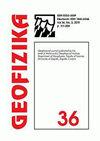TRMM降水雷达观测的季风季节印度次大陆云量的季节内变化
IF 1.1
4区 地球科学
Q4 GEOCHEMISTRY & GEOPHYSICS
引用次数: 7
摘要
以降雨“活跃”和“中断”阶段的形式表现出来的印度夏季风的季节内变率,研究了该地区对流和层状降水云模式的变率。本文使用了2002 - 2010年印度次大陆季风季节TRMM PR卫星(2A23和3B42数据集)的长周期数据。研究表明,印度中部季风槽区对流云量和层状云量与活跃期和中断期相关的空间变化最为显著。活跃期以正对流(~5%)和层状(~20%)降水云异常为特征。然而,前者的最大值比后者早1-2天,导致活跃期,表明层状云的积累是由于该地区对流云系统的逐渐组织所致。在中断阶段之前的日子里,该地区的对流和层状云量的负异常是显著的,它们彼此相一致,不像在活跃阶段之前。NCEP-NCAR再分析资料对该地区大气热源和汇的模式分析表明,季风槽区对流增长/衰减的发动机主要位于孟加拉湾和邻近的东印度。活跃期之前有一个加热模式,在实际开始之前促进了孟加拉湾大规模有组织的对流云的增长,而导致断裂期的加热模式促进了孤立对流云的形成和季风槽区云组织的衰减。本文章由计算机程序翻译,如有差异,请以英文原文为准。
Intra-seasonal variability of cloud amount over the Indian subcontinent during the monsoon season as observed by TRMM precipitation radar
The intra-seasonal variability of the Indian summer monsoon, which manifests in the form of “active” and “break” phases in rainfall, is investigated with respect to the variability of the convective and stratiform precipitating cloud pattern over the region. Long period data from TRMM PR satellite (2A23 and 3B42 datasets) for the monsoon season of 2002 to 2010 over the Indian subcontinent is used for this purpose. The study reveals that the most significant spatial variation in convective and stratiform cloud amount in relation to the active and break phase occurs over the monsoon trough region in central India. The active phase is characterized by positive convective (~5%) and stratiform (~20%) precipitating cloud anomalies over this region. However, the maximum of the former precedes the latter by 1–2 days leading up to the active phase, indicating that the stratiform build up, is due to the gradual organization of the convective cloud systems over the region. The days leading up to the break phase are marked by negative anomalies in the convective and stratiform fractions of cloudiness over this region, which are in phase with each other, unlike the lead-up to the active phase. Analysis of the pattern of atmospheric heat source and sinks over the region from the NCEP–NCAR re-analysis data indicates that the engine for the growth/decay of convection over the monsoon trough region lies primarily in the Bay of Bengal and adjacent east India. The active phase is preceded by a heating pattern that promotes large scale, organized convective cloud growth over the Bay of Bengal preceding the actual onset, while the heating pattern leading up to the break phase promotes the formation of isolated convective clouds and decay of cloud organization over the monsoon trough region.
求助全文
通过发布文献求助,成功后即可免费获取论文全文。
去求助
来源期刊

Geofizika
地学-地球化学与地球物理
CiteScore
1.60
自引率
0.00%
发文量
17
审稿时长
>12 weeks
期刊介绍:
The Geofizika journal succeeds the Papers series (Radovi), which has been published since 1923 at the Geophysical Institute in Zagreb (current the Department of Geophysics, Faculty of Science, University of Zagreb).
Geofizika publishes contributions dealing with physics of the atmosphere, the sea and the Earth''s interior.
 求助内容:
求助内容: 应助结果提醒方式:
应助结果提醒方式:


